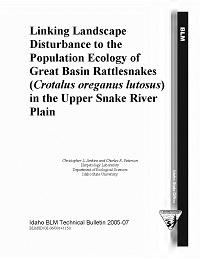Linking Landscape Disturbance to the Population Ecology of Great Basin Rattlesnakes (Crotalus oreganus lutosus) in the Upper Snake River Plain

Sagebrush steppe ecosystems throughout the Great Basin and Interior Columbia Basin are experiencing widespread landscape conversion due to livestock overgrazing, invasive plants, and fire. Previous studies have documented the effects of landscape conversion on birds and mammals but there is little information on the effects on reptiles. The Great Basin rattlesnake is a good species to study the potential influence of landscape conversion on reptiles because they are widely distributed, sympatric with many other species of reptiles, move long distances relative to other reptiles, and have life histories that are sensitive to variation in prey availability. We developed a study that links landscape disturbance to rattlesnake populations through a series of trophic interactions. We studied disturbance, substrate, vegetation, prey, and rattlesnakes at two study sites in the Upper Snake River Plain of southeastern Idaho. We used radio telemetry to track rattlesnakes while concurrently conducting habitat sampling and small mammal trapping in areas used by snakes and in random locations. We found lower biological crust cover, shrub cover, shrub height, and shrub dispersion and higher grass and bare soil cover in disturbed areas (i.e., areas with grazing and/or burning). In addition, at one study site, grass cover in disturbed areas was dominated by non-native invasive grasses such as cheatgrass and crested wheatgrass. Habitat characteristics associated with disturbance levels, such as shrub cover and shrub height, were important predictors of prey resources for snakes. We found lower small mammal biomass, abundance, and rabbit index values in disturbed areas. Small mammal species richness was lower in disturbed areas at only one site. Disturbed areas had lower proportions of large prey species (such as least chipmunks) and higher proportions of small prey species (such as pocket mice). Rattlesnake movements were not significantly different among disturbance categories. Snakes displayed preference for habitat characteristics typical of undisturbed sites, with the exception of a preference for areas with lower biological crust cover. Rattlesnake diets differed between study sites, and snakes showed preference for certain small mammals at the Crater Butte study site. Small mammal biomass within the rattlesnakes home range influenced how much weight the snakes gained during the active season. Overall, our study suggests that disturbance in sagebrush steppe ecosystems may cause a series of interactions that result in less energy acquisition by a top predator, the Great Basin rattlesnake. The results from this study have important implications for the conservation of sagebrush steppe habitats and wildlife. For example, management prescriptions that do not provide sufficient cover, or that promote altered disturbance regimes will have a negative impact on sagebrush steppe reptiles. This study highlights the importance of finding effective ways to prevent further landscape conversion and restoring previously converted areas of sagebrush steppe.
